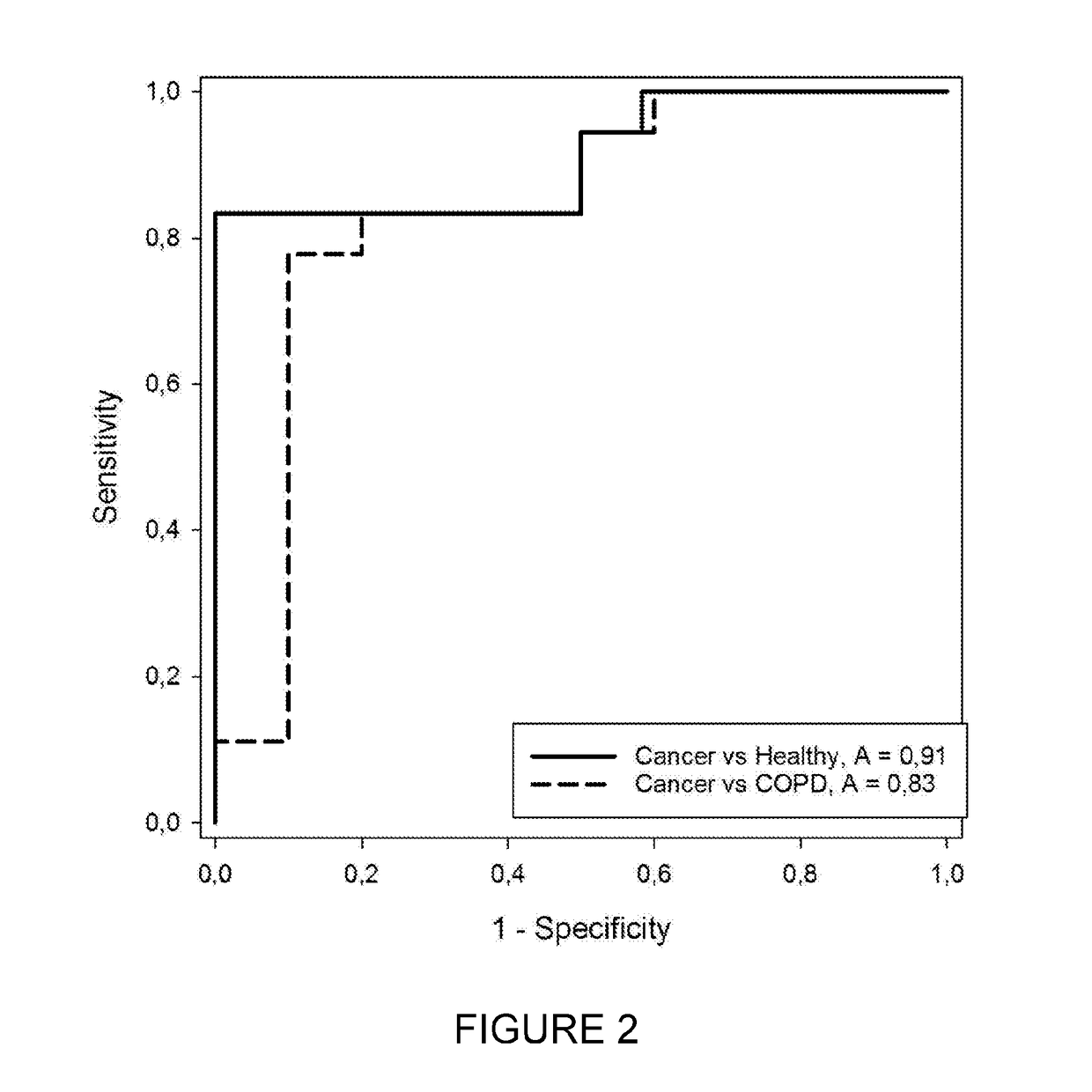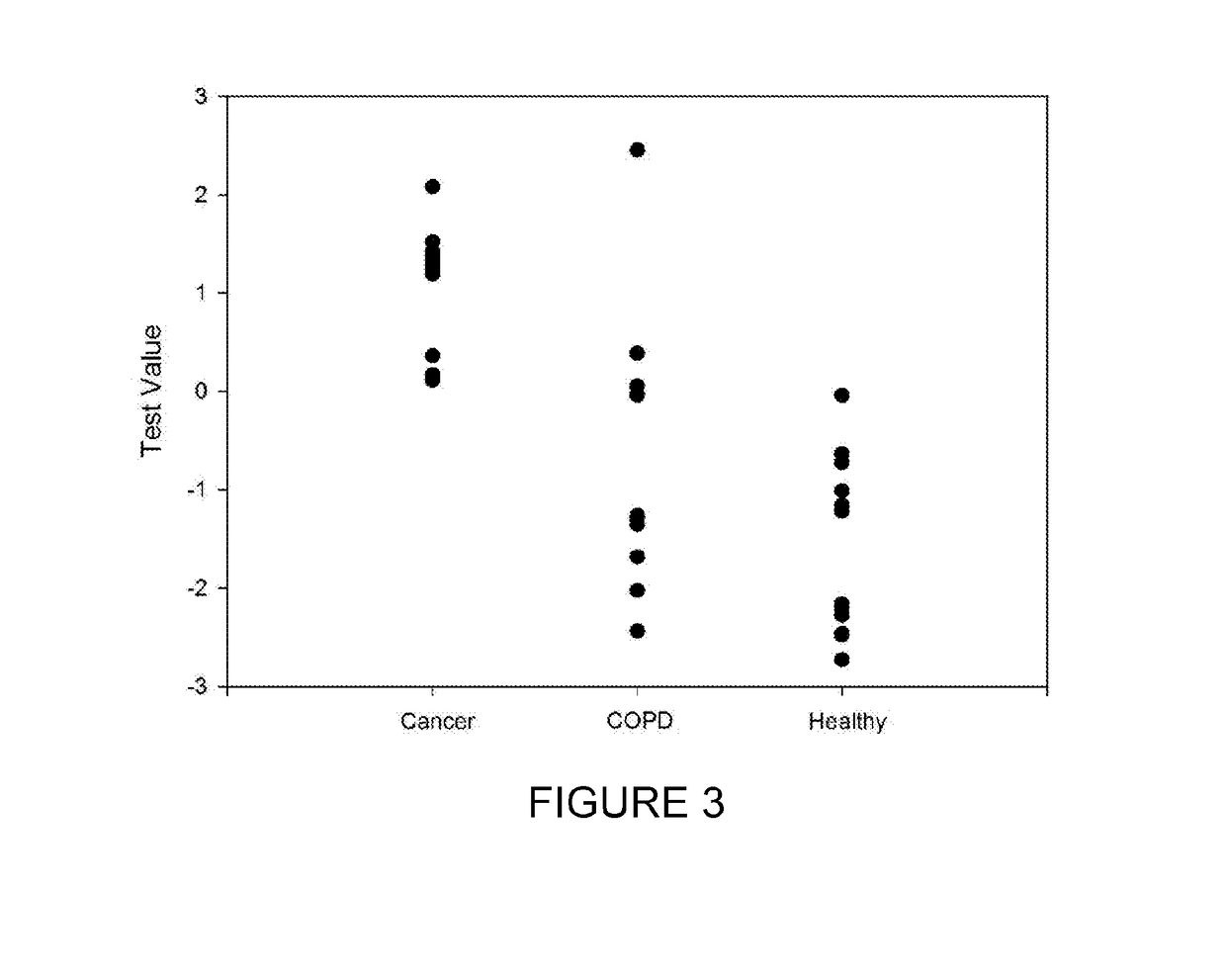Use of cell-free nucleosomes as biomarkers in sputum samples
a nucleosome and cell-free technology, applied in the field of cell-free nucleosomes, can solve the problems of poor clinical accuracy, patients exposed to potentially dangerous doses of x-rays, and low dos
- Summary
- Abstract
- Description
- Claims
- Application Information
AI Technical Summary
Benefits of technology
Problems solved by technology
Method used
Image
Examples
example 1
[0167]Sputum samples were collected from 17 treatment naïve subjects diagnosed with non-small cell lung cancer (NSCLC) including 2 subjects with stage T1 disease, 2 subjects with stage T2 disease, 5 subjects with stage T3 disease, 4 subjects with stage T4 disease and 4 subjects with disease of indeterminate stage Tx. Sputum samples were also collected from 10 subjects diagnosed with Chronic Obstructive Pulmonary Disorder (COPD) and 12 approximately aged match healthy control subjects. For collection, subjects were asked to breathe through a nebulizer containing NaCl solution to induce sputum formation for 5 minutes followed by coughing into a receptacle. If no sputum was produced this was repeated up to a maximum of 3 further times (i.e. up to a total of 20 minutes breathing on a nebulizer). The sample volume was measured and the sample was diluted 1+3 with phosphate buffered saline. The diluted sample was centrifuged to remove cellular material, filtered through a gauze and frozen ...
example 2
[0171]The Optical Density (OD) results of the various single epigenetic feature measurements, made in EXAMPLE 1 above, were compiled in various combinations to obtain test panel results. The discrimination of multiple panel ELISA methods of the invention to identify subjects with lung cancer from healthy subjects and from subjects with Chronic Obstructive Pulmonary Disorder (COPD) was determined using simple arithmetic mathematical models calculated using Fisher's linear discriminant analysis of the OD results for the individual ELISA methods. The results were evaluated using ROC analysis of the respective models and the calculated clinical sensitivities for some panel methods, at a clinical specificity of 100% and at 90%, are shown in Table 2.
TABLE 2The discrimination of some multiple panel ELISA methods of theinvention for subjects with lung cancer from healthy subjectsand for subjects with cancer from subjects with Chronic ObstructivePulmonary Disorder (COPD). Mathematical models...
example 3
[0174]A sputum sample is obtained from a lung cancer patient prior to a possible treatment regime with a drug or other therapy (for example an HDACi, HMTi, DNMTi or other epigenetic drug) and the epigenetic status of the tumor is assessed using a method of the invention (for example a 2-site immunoassay for nucleosomes containing a particular epigenetic feature or a panel of such 2-site immunoassays). The epigenetic status of sputum nucleosomes is used to determine which therapy is likely to be an effective or optimal treatment for the patient.
PUM
| Property | Measurement | Unit |
|---|---|---|
| pH | aaaaa | aaaaa |
| OD | aaaaa | aaaaa |
| mass spectroscopy | aaaaa | aaaaa |
Abstract
Description
Claims
Application Information
 Login to View More
Login to View More - R&D
- Intellectual Property
- Life Sciences
- Materials
- Tech Scout
- Unparalleled Data Quality
- Higher Quality Content
- 60% Fewer Hallucinations
Browse by: Latest US Patents, China's latest patents, Technical Efficacy Thesaurus, Application Domain, Technology Topic, Popular Technical Reports.
© 2025 PatSnap. All rights reserved.Legal|Privacy policy|Modern Slavery Act Transparency Statement|Sitemap|About US| Contact US: help@patsnap.com



